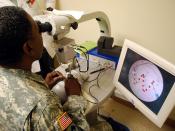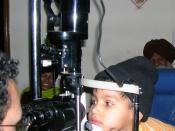IntroductionThe purpose of this report is to provide an accurate and detailed description of the Optoelectronic Retinal Prosthesis System (aka the Bionic Eye) and its function, along with the ethical implications of the device. It also looks at the bio-medical engineers responsible for maintaining this field, Ophthalmologists and the work they do. As an addition, historical information on the device and the development of this field will be explored, and recent innovations relating to the profession researched.
The history of Ophthalmology dates back to around the 5th Century BCE, the eye fascinating scientists and the general public alike since the beginnings of time. The beginnings start with IndiaÃÂs Sushruta describing 72 ocular diseases, as well as delving into several ophthalmologic surgical instruments and techniques. Among these diseases was cataract, and Sushruta is thought to have been the first Indian to specialise in this particular field.
Next Galen remedied eye deformities such as the curvature of the cornea and lens ÃÂ an idea further developed for the implication of the Bionic Eye. From here on in the study of Ophthalmology is accelerated with almost all developed nations (and even, surprisingly, some under-developed ones) participating in eye-based research.
Finally, after a solid twenty years of hard research, U.S. trials have begun with the retinal implant system, combining all the previous technologies and discoveries to give the blind a limited degree of vision. However limited, this innovation is a great achievement after all the development which has taken place, and for the receiving patients, it is truly a comfort from heaven.
Scope of the ProfessionA bioengineer is responsible for the design and creation of devices to assist a patient requiring the handicap, or else replacing human tissue and bone with a device which will perform in much the same way. They...


